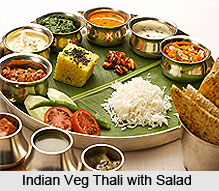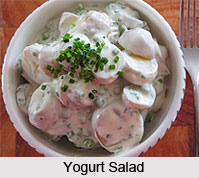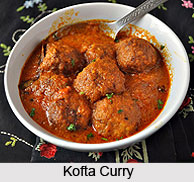 Indian meals are the reflection of the heritage of its people. They represent the historical development, religious beliefs, cultural practices and above all, its geographical attributes. Indian meals are, in fact, an amalgamation of the cuisines of many diverse regions. The unifying factor that brings all these varied cuisines under the heading of “Indian meal†is the ingenious way that fragrant herbs and aromatic spices are used in all the regions. Indian meal is the most aromatic of all cuisines and it is the cooking of captivating fragrances and intriguing flavours.
Indian meals are the reflection of the heritage of its people. They represent the historical development, religious beliefs, cultural practices and above all, its geographical attributes. Indian meals are, in fact, an amalgamation of the cuisines of many diverse regions. The unifying factor that brings all these varied cuisines under the heading of “Indian meal†is the ingenious way that fragrant herbs and aromatic spices are used in all the regions. Indian meal is the most aromatic of all cuisines and it is the cooking of captivating fragrances and intriguing flavours.
Even though India is one of the oldest civilizations, it has been enriched over a period of many centuries by the different cultures that were superimposed with each new invasion. These invaders brought with them new ideas and concepts which was developed by the Indians. With the introduction of new thoughts and processes of cooking, cooking ingredients and techniques spread to different regions of India, enhancing and refining the local cuisine. However, this influence was concentrated mainly in the North, where the new hordes primarily settled because of the similarity of the climate and landscape to those they came from. Furthermore, the natural barriers and great distances made migration to the South slow and infrequent. Thus northern cooking evolved far more over the centuries than other regional cuisines and attained unparalleled distinction. All these cultural, religious and geographical aspects have played a major role in influencing Indian meals and have shaped and developed it to what it is today.
With the increasing acceptance and popularity of authentic Indian meal, more and more Westerners are cooking it at home. These well-travelled and enterprising cooks have discriminating tastes and are uncompromising about the authenticity of food and flavours. As a result, several special ingredients needed for Indian meals that were previously unavailable have recently come onto the market.

Except for a few that are highly aromatic in their raw form, most spices have to be cooked before they release any of their fragrance. All spices, however, release more aromas when slightly crushed. The spice whose aroma is meant to predominate is generally added in large quantity, and the number of additional herbs and spices is reduced to a minimum to support this distinction. Because fresh herbs are essential to vegetarian cooking, they are cultivated all year round in India.
A traditional Indian meal, on the other hand, is served in one go and has no such thing as a main course. There is, however, a main dish. This status is given to a particularly elaborate preparation that is a culinary creation in and of itself. An Indian meal, on the other hand, is served all at once. All the dishes are either placed at the centre of the table, so that everyone can help himself to each dish, or served in the classic manner in a "thali". A "thali" is a large, rimmed metal plate containing several small metal bowls. The various dishes, including soup and dessert, are served in these small bowls. The wafers, relishes and pickles are put directly in one corner of the plate and the centre of the plate is reserved for the staple rice or bread. An Indian meal essentially consists of three dishes: a main dish, a side dish and a staple. Of course there is nothing to prevent you serving more than one dish from each category, particularly several side dishes. A staple must accompany an Indian meal.
A main dish in Indian meal can either be non-vegetarian or vegetarian. The non-vegetarian main dish can consist of meat, poultry, fish, shellfish or eggs, and their products. A vegetarian main dish, on the other hand, consists of vegetables, "dal" of all varieties or Indian cheese. Vegetarian main dishes usually have gravies and frequently require special preparation. A side dish in Indian meal can either be vegetables or "dal" or yogurt salads. These vegetable preparations differ from the vegetable main dishes in that they are usually stir-fried and require very little time to prepare. "Dal" preparations are basically soupy purees flavoured with fragrant spices and herbs. These "dal" side dishes are very different from the main dish "dais" which are usually cooked with vegetables as stews, or turned into dumplings, koftas, or rolls.
 An accompanying staple in Indian meal can be either rice or bread. An Indian meal is not complete without bread or a rice dish. Generally rice is served with the soupier dishes, and bread with the drier ones. This is why most dishes, including the legume preparations served in areas where bread is the staple, as in the North, are much drier and have thick, almost non-existent gravies. In the South, where rice is the staple, the dishes are soupy and much like broth.
An accompanying staple in Indian meal can be either rice or bread. An Indian meal is not complete without bread or a rice dish. Generally rice is served with the soupier dishes, and bread with the drier ones. This is why most dishes, including the legume preparations served in areas where bread is the staple, as in the North, are much drier and have thick, almost non-existent gravies. In the South, where rice is the staple, the dishes are soupy and much like broth.
Traditionally in India appetizers and sweetmeats are eaten as snacks. There are several appetizers that make an excellent first course. They also make a grand opening for an elegant meal. Desserts should be served immediately following the meal. Indian desserts are primarily milk-based, and their consistency is much like creamy pudding or foamy custard. Some are served fresh while they are still warm, others are frozen into ice cream, but most are served at room temperature or chilled.




















